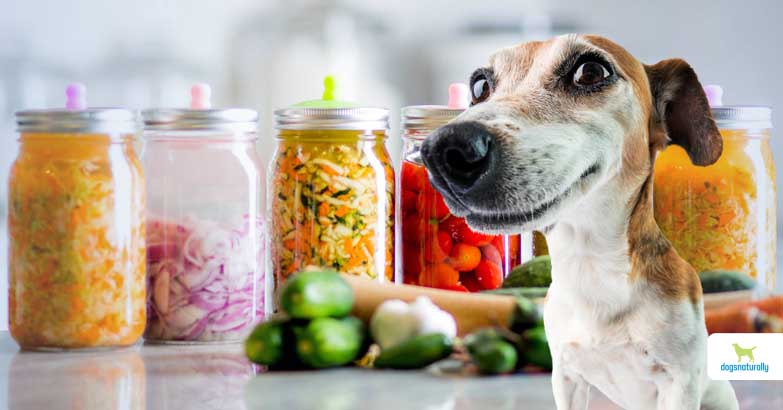Fermented foods can be a great addition to your dog’s diet. But there are some pros and cons you should know about feeding your dog fermented veggies.
Fermented Vegetables For Dogs
The process of fermenting vegetables is simple and effective. Food comes into contact with beneficial bacteria and yeast. Then these continue to grow when they’re in an area at room temperature. Those bacteria and yeasts do important work by predigesting the plant’s sugars. This process turns the sugars into lactic acid and removes the adverse effects of feeding vegetables: the carbohydrates that can be hard to digest.
A dog’s digestive tract is shorter than a human’s. As carnivores, they adapted to eat animals and raw meat. The nutrients from these foods are more efficient and require less conversion. The opposite is true with raw vegetables and plants so your dog needs them broken down for him.
Pros Of Fermented Vegetables For Dogs
Fermented vegetables are an efficient way to supplement your pet’s diet with superfoods. When you rotate fermented vegetables, you’re giving your dog a variety of nutrients.
While pre-digesting the vegetables, those same bacteria and yeast produce extra vitamins and enzymes. As if they haven’t done enough for him already, when your dog eats the vegetables, all those bacteria become food-sourced probiotics.
Fermented vegetables keep for a very long time in your fridge. Then you can add them to your dog’s dinner several times a week. A little goes a long way. Give your dog 1 half to 1 teaspoon per 20 pounds of his body weight. Unlike fresh vegetables, there’s no need to grind fermented vegetables before feeding them, as they’re now much easier for your dog to digest. Rotate between fermented and fresh organic vegetables as much as possible.
RELATED: Make some fermented veggies for your dog …
8 Benefits of Feeding Dogs Fermented Vegetables
Fermented foods are a simple way to promote healthy bacteria in your dog’s gut and edge out harmful bacteria. When your dog is on processed pet food or doesn’t get enough exercise, he can have digestive issues. Adding fermented veggies can give your dog a boost of nutrients.
- Help maintain a healthy gut flora, the good bacteria in your dog’s gut.
- Break down nutrients like carbohydrates and proteins.
- Increase prebiotics (fermented food and herbs are good sources) that feed probiotics and other friendly bacteria in the digestive tract.
- Help prevent diabetes by improving glucose tolerance.
- An excellent source of antioxidants, fiber and phytonutrients.
- Minerals, vitamins and enzymes in vegetables become more digestible and absorption is better.
- Boost immune system function as healthy gut bacteria fight bad bacteria that lead to infection, disease, parasites and worms.
- Boost natural melatonin to regulate your dog’s sleep-wake cycle. And it may have anti-anxiety effects on your dog.
But before there were veggies to ferment, there were microgreens. If allowed to grow, these potent plants will become mature vegetables. So let’s take a quick look at the power of microgreens in your dog’s diet.
Microgreens Are Good For Dogs
Plants begin life as microgreens. It’s the most nutrient-rich part of a plant’s life. And this is why they’re great to add to your dog’s diet. Instead of establishing or bearing fruit, the plant is producing vitamins and antioxidants to grow. So your dog can benefit from them too.
There have been scientific studies of nutrient levels in microgreens, and there’s good news. During this early stage, vitamin content is 40 to 400 times more nutrients by weight than their adult counterparts!
They’ve been shown to lower the risk of heart disease, cancer and diabetes. But what’s really amazing is that broccoli microgreens contain between 10 and 100 times the amount of sulforaphane of adult plants. Sulforaphane is a well-researched sulfate compound that’s been shown to combat cancer.
PRO TIP
Microgreens aren’t the same as sprouts. Sprouts are different from microgreens because sprouts don’t have leaves. You just eat the seeds and sprout or stem. They’re usually harvested 2-7 days after germination. Microgreens need a few days more growth time to produce their leaves.
Can You Ferment Microgreens?
Yes, you can. Because they’re so tiny, it’s probably best to include them with other veggies when you ferment them.
Common microgreens are broccoli, chia, spinach, alfalfa, wheatgrass, lettuce, red cabbage and other veggies. Add some microgreens to the jar when you ferment veggies for your dog.
RELATED: Your dog needs these antioxidants in his diet …
Now let’s look at the cons of fermented vegetables and why they aren’t always the best choice for your dog.
Cons Of Fermented Foods For Dogs
Fermented food has become the flavor of the month in dog diets. It has a lot of value for a healthy dog. But it can do more harm than good to a dog with gut trouble, or who’s fighting an infection or yeast.
Fermented Foods Feed Yeast
Instead of helping rid your dog of yeast, foods like yogurt, kefir, kimchi and kombucha will make it worse. During the fermentation process, bacteria and yeast feed on the carbohydrates and sugars in the food. But the prebiotics found in fermented food will also feed the yeast in your dog’s intestines! Instead, what you need to do is starve the yeast. For now, you should avoid fermented foods until your dog no longer has a yeast problem.
Histamine Intolerance From Fermented Food
Fermented vegetables should only be added to a healthy dog’s diet. And even then, too much of a good thing can create problems. This is because fermented foods are filled with histamines.
If your dog has an allergic reaction, mast cells (a part of his immune system) in his body release histamines. That causes inflammation to increase blood flow so immune cells can react. That’s when you’ll see symptoms in your dog like skin rashes or a change in his breathing.
During fermentation, bacteria break down proteins resulting in histamines. Now your dog is getting doses of histamines along with his fermented foods.
These are signs of histamine intolerance:
- Nausea
- Diarrhea
- Flatulence
- Inflammation
- Lethargy
- Skin rashes
- Itching
In addition, your dog might also have more severe signs:
- Irregular heart rate
- Anxiety
- Aggressiveness
- Dizziness
- SIBO
- Mast cell tumors
So if you’re feeding your dog fermented foods regularly and he’s experiencing any of these things, that could be the problem.
One Probiotic Doesn’t Fit All
Different probiotics address different health conditions so you need to know the right type to feed your dog to address a specific condition. Choosing a fermented food with a non-specific probiotic may not give you the results you want. And it could cause greater harm to your dog as in the case of a dog with yeast.
Instead of taking a chance with fermented food, the best way to know you’re getting probiotics is to use supplements that identify the strains and the CFUs. Then you’re really doing something healthy for your dog’s gut.
RELATED: Find out which probiotics work best for your dog …
Not All Fermented Foods Are Probiotic
To be probiotic, certain live microbes must be present … and able to survive the gut environment and colonize. One probiotic fermented food that can survive digestion in the gut is kefir. And probiotics contain identified bacteria species that provide a health benefit when used in adequate amounts.
Some fermented veggies do have probiotic species like Bifidobacteria and Lactobacillus. Bifidobacteria is a probiotic species commonly found in foods and supplements. Lactobacillus is the species that produces lactase, the enzyme that breaks down lactose or milk sugar. It also has lactic acid that fights harmful bacteria. It also serves as muscle fuel and increases the body’s absorption of minerals. And there are other strains within these two species.
Fermented food may or may not contain the live microbes you want for your dog. Many fermented vegetables like kimchi, sauerkraut and pickles do contain the above species. But that’s not to say they’re found in all of them. Fermented veggies are a boost to your dog’s diet anyway, so go ahead and add them if you’re not looking for probiotic support.
But if you need specific probiotics, it’s a better idea to look for the strains you need and get them as a supplement. Then you’ll be able to choose ones with a sufficient number of CFUs (colony forming bacteria). Or if you buy fermented foods, ask the manufacturer which bacteria species are in the product.
Prebiotics, Probiotics and Postbiotics
In fact, fermented foods are more prebiotic than probiotic. A main component of fermented vegetables is dietary fiber … and that’s a valuable prebiotic that nourishes the probiotics. Bacteria in the fermentation process are probiotics. They consume the prebiotics, and the resulting “waste” is postbiotics.
As more is learned about the microbiome, it turns out that it’s the postbiotics that may be providing the actual health benefits.
Benefits Of Postbiotics
Here’s why your dog needs postbiotics.
- Supports probiotics
- Reduces inflammation
- Lower blood sugar
- Treats diarrhea
- Antimicrobial properties
- Supports immune function
Just as you rotate protein sources, it’s important to rotate the vegetables you’re feeding your dog. And you want to rotate fermented vegetables as well as microgreens to benefit from the nutritional levels you get from their different life stages too.
References
- Huang, Haiqiu, et al. Red Cabbage Microgreens Lower Circulating Low-Density Lipoprotein (LDL), Liver Cholesterol, and Inflammatory Cytokines in Mice Fed a High-Fat Diet. J. Agric. Food Chem. 2016, 64, 48, 9161–9171.
- Head, E., et al. Effects of age, dietary, and behavioral enrichment on brain mitochondria in a canine model of human aging. Exp Neurol. 2009 Nov;220(1):171-6.
- Dimidi, Eirini, et al. Fermented Foods: Definitions and Characteristics, Impact on the Gut Microbiota and Effects on Gastrointestinal Health and Disease. Nutrients. 2019 Aug; 11(8): 1806.
- Park, Da Hyde, et al. Effect of Fermented Medicinal Plants as Dietary Additives on Food Preference and Fecal Microbial Quality in Dogs. Animals (Basel). 2019 Sep; 9(9): 690.












